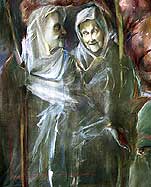home | paintings | drawings | style | collection | information | pricelist | sitemap | contact
![]()
click
on images
|
The Following
Describes Moser's Various Methods of Painting
|
|
GLAZING is a method of applying transparent layers of color over paint, allowing whatever lies beneath to remain visible. It is usually applied in several successive thin coats to thoroughly dried areas of the painting. Pigments are thinned with a mixed oil medium containing linseed oil, varnish and turpentine, known as a glazing compound. Glazed oil paint has a richness and depth that adds luminosity to the selected area. Achieving the right degree of tonal uniformity and saturation requires much skillful manipulation after the glazing compound has been applied. In the portrait shown above, Moser has incorporated several of the glazing principles commonly practiced by the Italian Renaissance painters. |
|
IMPRIMATURA relies upon the use of an opaque colored ground or toned underpainting applied to the canvas before the actual painting begins. The intended purpose is to provide an overall foundation for the building up of modeled tonal areas. By working over a mid-toned underpainting, highlights and shadows can be economically applied, achieving an immediate sense of dimensionality. To most sixteenth century painters, the preferred ground colors were in the yellow ochre to burnt umber range, although many painters experimented with their own individual color blends. The detail shown above well illustrates the imprimatura method where the use of light-toned pigments have been applied to the noticeable underpainting beneath. |
top | home | paintings | drawings | style | collection | information | pricelist | sitemap | contact

